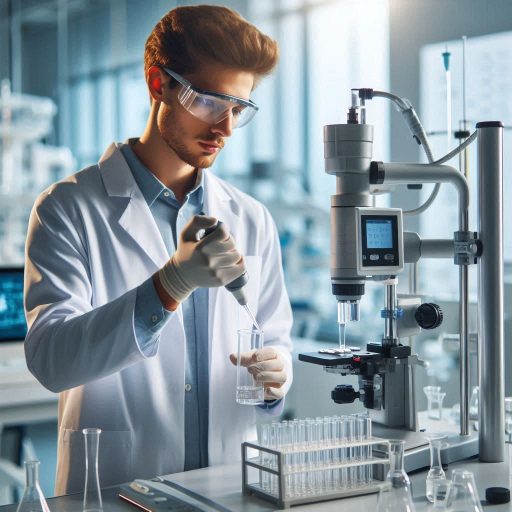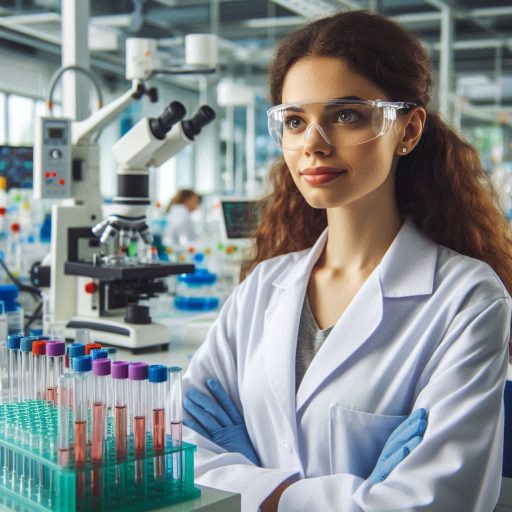Introduction
Biomedical engineering combines engineering principles with medical sciences to advance healthcare.
This field involves designing and developing medical devices, diagnostic tools, and treatments that improve patient care and outcomes.
Biomedical engineers work on a wide range of projects, from developing advanced imaging systems to creating innovative prosthetics.
Artificial organs are one of the most groundbreaking innovations in biomedical engineering.
These devices are engineered to replicate or support the function of natural organs.
They range from artificial hearts and kidneys to more complex systems like artificial livers.
Artificial organs can either fully replace a failing organ or assist its function, providing a critical alternative for patients who cannot receive a natural organ transplant.
The development of artificial organs is incredibly important in biomedical engineering for several reasons.
First, they address the severe shortage of donor organs, providing life-saving options for patients who would otherwise face limited treatment choices.
As the demand for organ transplants grows, artificial organs offer a viable solution to alleviate this shortage.
Artificial organs embody the transformative potential of biomedical engineering.
By creating devices that replace or support failing organs, this field not only addresses critical medical challenges but also enhances patient care and survival.
History of Artificial Organs Development
The development of artificial organs is a fascinating journey through medical and engineering history.
This field has evolved significantly, leading to revolutionary advancements in healthcare.
Timeline of Artificial Organs Development
- Early Concepts (1950s-1960s): The idea of artificial organs began to take shape. Initial experiments focused on developing basic prototypes.
- First Successful Implant (1960s): The first successful implant of an artificial organ occurred with the development of the artificial heart.
- Early 1970s: Researchers introduced the first dialysis machines, providing an artificial kidney function for patients with renal failure.
- 1980s-1990s: The development of more sophisticated artificial organs took place, including advances in artificial hearts and improved dialysis technologies.
- 2000s-Present: Modern advancements include bioengineered organs and complex devices that closely mimic natural organ functions.
Key Milestones in the Field
- 1966: Dr. Barney Clark received the first permanent artificial heart implant. This milestone demonstrated the potential for life-saving technology.
- 1972: The development of the first successful kidney dialysis machine revolutionized treatment for patients with chronic kidney disease.
- 1982: The first successful implantation of a total artificial heart marked a significant breakthrough, offering new hope to patients with severe heart conditions.
- 2000: Advances in tissue engineering led to the development of bioartificial organs, integrating living cells with synthetic materials.
- 2010s: Researchers achieved major progress with 3D-printed organs and more advanced artificial hearts, enhancing functionality and patient outcomes.
Evolution of Artificial Organs from Past to Present
- Early Innovations: The initial focus was on creating basic models of artificial organs.
These early devices laid the groundwork for future advancements but had limitations in function and durability. - Technological Advancements: Over the decades, technology improved rapidly. Early artificial organs were bulky and had limited functionality.
Today‘s devices are more sophisticated and can closely replicate natural organ functions. - Bioengineering Breakthroughs: Modern artificial organs incorporate bioengineering principles, combining synthetic materials with living cells.
This approach enhances compatibility and reduces the risk of rejection. - Current Trends: Today, researchers focus on developing organs that can grow and adapt within the human body.
Advances in 3D printing and tissue engineering are leading the way in creating more personalized and functional artificial organs. - Future Directions: The future of artificial organs includes integrating advanced technologies like AI and robotics to improve performance.
Researchers aim to create fully functional organs that seamlessly integrate with the body, offering even greater hope for patients.
The history of artificial organs development reflects a remarkable evolution from early prototypes to sophisticated devices.
Key milestones have paved the way for modern innovations, transforming the field and offering new possibilities for patients worldwide.
The continued advancement in this area promises further improvements in medical treatments and patient care.
Challenges Faced in Developing Artificial Organs
Rejection by the body
One of the primary challenges faced in developing artificial organs is the body’s natural tendency to reject foreign objects.
The immune system views artificial organs as foreign invaders and initiates an immune response, leading to rejection.
This rejection can result in severe consequences and even failure of the artificial organ.
Compatibility issues
Another significant challenge is ensuring compatibility between the artificial organ and the recipient’s body.
Factors such as size, shape, material, and functionality play a crucial role in determining the compatibility of the artificial organ.
Any mismatch can lead to complications and reduced effectiveness of the organ.
Durability
Durability is a crucial factor in the development of artificial organs.
The artificial organ must be able to withstand the rigors of daily use and continue to function effectively for an extended period.
Ensuring durability involves selecting the right materials, designing a robust structure, and testing the organ under various conditions to assess its longevity.
Cost
The cost of developing artificial organs can be prohibitive.
From research and development to manufacturing and clinical trials, the expenses involved in creating artificial organs are significant.
Cost-effective solutions need to be explored to make artificial organs more accessible to patients in need.
Ethical considerations
Ethical considerations are paramount in the development of artificial organs.
Issues such as informed consent, privacy, equity in access, and human experimentation must be carefully addressed.
Ethical guidelines and regulations play a vital role in ensuring that artificial organs are developed and used in an ethical and responsible manner.
Developing artificial organs poses several challenges, including rejection by the body, compatibility issues, durability concerns, high costs, and ethical considerations.
Addressing these challenges requires a multidisciplinary approach, combining expertise in biomedical engineering, materials science, immunology, and ethics.
Researchers and developers can overcome these obstacles to create more effective, accessible artificial organs.
This progress will significantly improve patients’ quality of life.
Read: Comparison: Architecture Styles across American Regions.
Advances in technology for artificial organs development
Advances in technology have revolutionized the field of artificial organs development.
Researchers and scientists are constantly exploring new techniques and methodologies to enhance the functionality and efficiency of artificial organs.
Here are some key technological advancements that have significantly contributed to the development of artificial organs.
3D Printing
One of the most groundbreaking technologies in artificial organs development is 3D printing.
This innovative technique allows researchers to create complex structures with high precision and accuracy.
3D printing has revolutionized the manufacturing process of artificial organs by enabling the production of customized and patient-specific implants.
Biomaterials
Biomaterials play a crucial role in the development of artificial organs. These materials are designed to interact with biological systems without causing any harm.
Advances in biomaterials have led to the creation of biocompatible and bioresorbable materials that can mimic the natural properties of tissues and organs.
Tissue Engineering
Tissue engineering is another cutting-edge technology that has greatly influenced the development of artificial organs.
This interdisciplinary field combines principles of engineering, biology, and medicine to create functional tissues and organs in the laboratory.
By overcoming these obstacles, researchers and developers will create more effective, accessible artificial organs.
These organs will significantly improve patient quality of life.
Nanotechnology
Nanotechnology is a rapidly growing field that holds immense potential in the development of artificial organs.
Nanomaterials have unique properties at the nanoscale, which can be leveraged to enhance the performance and functionality of artificial organs.
Researchers are investigating the use of nanomaterials for drug delivery, tissue regeneration, and bioimaging in artificial organs.
Biocompatibility Testing
Biocompatibility testing is essential for ensuring the safety and efficacy of artificial organs.
This process involves evaluating the compatibility of artificial organs with the biological environment to prevent adverse reactions.
Advances in biocompatibility testing have enabled researchers to identify potential risks and improve the design of artificial organs for better clinical outcomes.
These advancements have led to innovative and sophisticated artificial organs that better replicate natural organ functions.
Scientists, engineers, and medical professionals are actively researching and collaborating on artificial organs.
Their work promises life-saving interventions and a bright future.
Read: Exploring Architect Salary Trends: USA Analysis.
Success stories in artificial organs development
Biomedical engineering has made significant advancements in creating artificial organs that have revolutionized the medical industry.
Here are some examples of successfully developed artificial organs:
Examples of successfully developed artificial organs
- Artificial Hearts: Devices like the SynCardia Total Artificial Heart save countless lives. They provide temporary heart support for patients awaiting transplants.
- Artificial Kidneys: The development of wearable artificial kidneys offers hope to patients with end-stage renal disease by providing continuous dialysis.
- Artificial Lungs: Devices like the Hemolung Respiratory Assist System help patients with severe lung conditions breathe easier and enhance their quality of life.
These artificial organs have had a profound impact on patients’ lives:
Transform Your Career Today
Unlock a personalized career strategy that drives real results. Get tailored advice and a roadmap designed just for you.
Start NowImpact on patients’ lives
- Increased lifespan: Artificial organs have extended the lives of patients who would not have survived without them.
- Improved quality of life: Patients with artificial organs can lead more active and fulfilling lives.
- Reduced dependence on donor organs: Artificial organs offer a solution for patients on transplant waiting lists.
The future potential of artificial organs is vast, with ongoing research and development in the field
Future potential of artificial organ
- Enhanced functionality: Artificial organs continue to improve in terms of performance and durability.
- Customized solutions: Personalized artificial organs tailored to individual patients’ needs are on the horizon.
- Integration with technology: Artificial organs may be connected to smart devices for real-time monitoring and adjustment.
Overall, the success stories in artificial organs development highlight the incredible impact of biomedical engineering on healthcare outcomes.
The future holds even more promise for innovative solutions that will transform patients’ lives for the better.
Read: The Role of NCARB in US Architecture Licensing.
Collaborations in artificial organs development
Collaboration between engineers, scientists, and medical professionals
One of the key components in the development of artificial organs is the collaboration between engineers, scientists, and medical professionals.
Each group brings a unique set of skills and knowledge to the table, which is essential for the success of the project.
Engineers play a crucial role in designing and building artificial organs.
They are responsible for ensuring that the organs are structurally sound, functional, and safe for use in humans.
Engineers also work on the materials used in the organs, ensuring that they are biocompatible and durable.
Scientists contribute their expertise in biology, chemistry, and other related fields to the development of artificial organs.
They work on understanding the biological processes involved in organ function and disease, which is essential for designing effective artificial organs.
Scientists also play a role in testing and evaluating the organs to ensure they meet the necessary standards.
Medical professionals, including doctors, surgeons, and other healthcare professionals, provide valuable insights into the clinical aspects of artificial organs.
They help identify the specific needs and challenges faced by patients in need of organ transplants, which informs the design and development of artificial organs.
Medical professionals also play a role in testing the organs in clinical settings and providing feedback on their performance.
Importance of interdisciplinary teamwork
Interdisciplinary teams drive artificial organ development. They ensure a holistic and comprehensive approach to designing these life-saving devices.
By bringing together experts from different fields, interdisciplinary teamwork ensures that all aspects of the project are considered and addressed.
Collaborating across disciplines bridges gaps between expertise areas. Engineers, scientists, and medical professionals innovate solutions and breakthroughs.
They leverage each other’s skills to overcome challenges. This teamwork creates more effective, efficient artificial organs.
Interdisciplinary teamwork also fosters creativity and innovation by encouraging collaboration and communication among team members.
Team members share ideas, feedback, and best practices. This collaboration improves the quality of artificial organs. The result is better patient care.
Case studies of successful collaborations
There are many examples of successful collaborations in the development of artificial organs that have led to groundbreaking advancements in the field.
One such example is the development of the artificial pancreas, a device that can regulate blood sugar levels in patients with diabetes.
Engineers collaborated with scientists and medical professionals to design and test the artificial pancreas. Patients worldwide now use it to manage diabetes more effectively.
The collaboration developed a device that mimics the pancreas’s function. This device helps patients control blood sugar levels more reliably and accurately.
Another example of successful collaboration in artificial organs development is the development of artificial hearts.
Engineers, scientists, and medical professionals worked together to design and test artificial hearts that can be used to replace damaged or failing hearts in patients.
These artificial hearts have saved countless lives and have revolutionized the field of organ transplantation.
Overall, collaborations between engineers, scientists, and medical professionals are essential for the successful development of artificial organs.
These experts collaborate to leverage their skills and knowledge. They create innovative solutions that benefit patients needing organ transplants.
Read: 5 Essential Software Tools Every US Architect Uses.

Discover More: Top Skills Needed for a Marine Engineer Career
Delve into the Subject: Transportation Engineering Internships: What to Expect
Regulatory aspects of artificial organs development
Developing artificial organs in the field of biomedical engineering requires adhering to strict regulatory guidelines to ensure safety, efficacy, and performance.
This section explores regulatory aspects of developing artificial organs. We will cover the FDA approval process and clinical trials.
We will also discuss safety and efficacy standards, along with regulatory challenges and opportunities.
FDA Approval Process
- Artificial organs must undergo a rigorous approval process by the Food and Drug Administration (FDA) before they can be introduced to the market.
- The FDA evaluates the safety and effectiveness of artificial organs through preclinical testing, clinical trials, and post-market surveillance.
- Manufacturers must submit detailed documentation of the design, materials, manufacturing process, and intended use of the artificial organ for FDA review.
- Approval from the FDA is crucial for ensuring that artificial organs meet quality standards and regulatory requirements.
Clinical Trials
- Clinical trials play a vital role in testing the safety, efficacy, and performance of artificial organs in human subjects.
- Participants in clinical trials are closely monitored to assess the impact of artificial organs on their health and well-being.
- Results from clinical trials help researchers and developers identify any potential risks or side effects associated with artificial organs.
- By gathering data from clinical trials, manufacturers can make informed decisions on improving the design and functionality of artificial organs.
Safety and Efficacy Standards
- Regulatory agencies set stringent safety and efficacy standards that artificial organs must meet to ensure patient safety.
- Manufacturers must conduct thorough risk assessments and performance evaluations to demonstrate compliance with these standards.
- Adhering to safety and efficacy standards helps minimize the risks of adverse events and enhances the overall quality of artificial organs.
- Continuous monitoring and evaluation of artificial organs are essential to maintain safety and efficacy standards throughout their lifecycle.
Regulatory Challenges and Opportunities
- Developing artificial organs faces regulatory challenges due to innovative technologies.
Novel regulatory pathways are often required. - Regulatory challenges may include navigating complex approval processes, demonstrating clinical relevance, and addressing ethical and legal considerations.
- Opportunities exist for collaboration between regulatory agencies, industry stakeholders, and researchers to streamline the process.
- Stakeholders can collaborate to overcome regulatory hurdles and accelerate artificial organ development by sharing best practices.
The regulatory aspects of artificial organs development play a crucial role in ensuring the safety, efficacy, and quality of these innovative medical devices.
By adhering to regulatory guidelines, researchers and manufacturers can advance artificial organs and improve patient outcomes.
Conduct robust clinical trials to meet regulatory standards and ensure safety.
Address regulatory challenges to propel the field forward and enhance patient care.
Future Trends in Artificial Organs Development
The future of artificial organs is bright, driven by advancements in personalized medicine, biohybrid devices, artificial intelligence (AI), and organ-on-a-chip technology.
These innovations are poised to revolutionize healthcare and offer new possibilities for treating organ failure.
Personalized Medicine
Personalized medicine tailors medical treatments to individual patients based on their unique genetic, environmental, and lifestyle factors.
In artificial organs development, this approach has significant potential:
Showcase Your Business Today
Reach thousands of readers actively exploring professional services. Publish your business profile and grow your audience now.
Publish Now- Customized Organs: Engineers can design artificial organs that fit the specific anatomical and physiological needs of each patient.
- Genetic Compatibility: Artificial organs can be tailored to match a patient‘s genetic profile, reducing the risk of rejection.
- Patient-Specific Treatments: Personalized organs can deliver targeted therapies directly to the site of disease, enhancing treatment efficacy.
Biohybrid Devices
Biohybrid devices combine biological and synthetic components to create more functional and adaptable artificial organs.
These devices represent a significant leap forward in the field:
- Enhanced Biocompatibility: Incorporating living cells into artificial organs improves integration with the human body.
- Improved Functionality: Biohybrid devices can better mimic natural organ functions, leading to improved patient outcomes.
- Adaptive Responses: These devices can respond to the body‘s changing conditions, providing more effective and dynamic support.
Artificial Intelligence Integration
Artificial intelligence (AI) is transforming healthcare, and its integration into artificial organs development offers exciting possibilities
- Real-Time Monitoring: AI can enable continuous monitoring of artificial organ performance, allowing for real-time adjustments and improvements.
- Predictive Maintenance: AI algorithms can predict when an artificial organ might fail, enabling preemptive interventions.
- Enhanced Decision-Making: AI can analyze vast amounts of data to optimize the design and function of artificial organs.
Organ-on-a-Chip Technology
Organ-on-a-chip technology involves creating miniature models of human organs on microchips, allowing for advanced research and development:
- Drug Testing: Researchers can use organ-on-a-chip models to test new drugs on artificial organs, speeding up the development process.
- Disease Modeling: This technology allows scientists to study diseases in a controlled environment, leading to better understanding and treatment options.
- Precision Engineering: Organ-on-a-chip models provide insights into organ function, guiding the design of more effective artificial organs.
Challenges and Opportunities for Future Advancements
The development of artificial organs faces several challenges and opportunities
- Technical Complexity: Creating artificial organs that perfectly mimic natural ones remains a significant challenge.
- Regulatory Hurdles: Navigating the regulatory landscape requires careful planning and collaboration between developers and regulatory bodies.
- Ethical Considerations: As technology advances, ethical questions about artificial organs will need to be addressed.
- Opportunities for Collaboration: Collaboration between engineers, medical professionals, and researchers can accelerate innovation and overcome these challenges.
The future of artificial organs development looks promising, driven by personalized medicine, biohybrid devices, and AI integration.
Organ-on-a-chip technology is also leading the way in advancing artificial organs.
Challenges remain, but the opportunities for progress are immense, offering hope for better patient care.
As these trends evolve, artificial organs will shape the future of medicine significantly.
Conclusion
Artificial organs represent one of the most significant advancements in biomedical engineering, offering innovative solutions for patients suffering from organ failure.
These devices have revolutionized medical care, providing life-saving alternatives where traditional treatments may not suffice.
The ability to replicate or support the functions of natural organs marks a critical milestone in modern medicine.
The significance of artificial organs in healthcare cannot be overstated.
They not only save lives but also improve the quality of life for patients who might otherwise face severe limitations due to organ failure.
The progress made in this field underscores the importance of continued research and development.
By pushing the boundaries of what artificial organs can achieve, we open new avenues for treatment and care, making a profound impact on patient outcomes.
The future holds great promise, with artificial organs set to play an increasingly vital role in medicine.
Foster innovation and support ongoing research to ensure these life-saving devices continue evolving.
Provide hope and improve the quality of life for patients worldwide.
The impact of artificial organs on healthcare and patient outcomes is profound, and their potential is limitless.
[E-Books for Sale]
The Big Book of 500 High-Paying Jobs in America: Unlock Your Earning Potential
$19.99 • 500 High-Paying Jobs • 330 pages
Explore 500 high-paying jobs in America and learn how to boost your career, earn more, and achieve success!
See All 500 High-Paying Jobs of this E-Book
1001 Professions Without a Degree: High-Paying American Jobs You Can Start Now
$19.99 • 1001 Professions Without a Degree • 174 pages
Discover 1001 high-paying jobs without a degree! Unlock career tips, skills, and success strategies for just $19.99!




